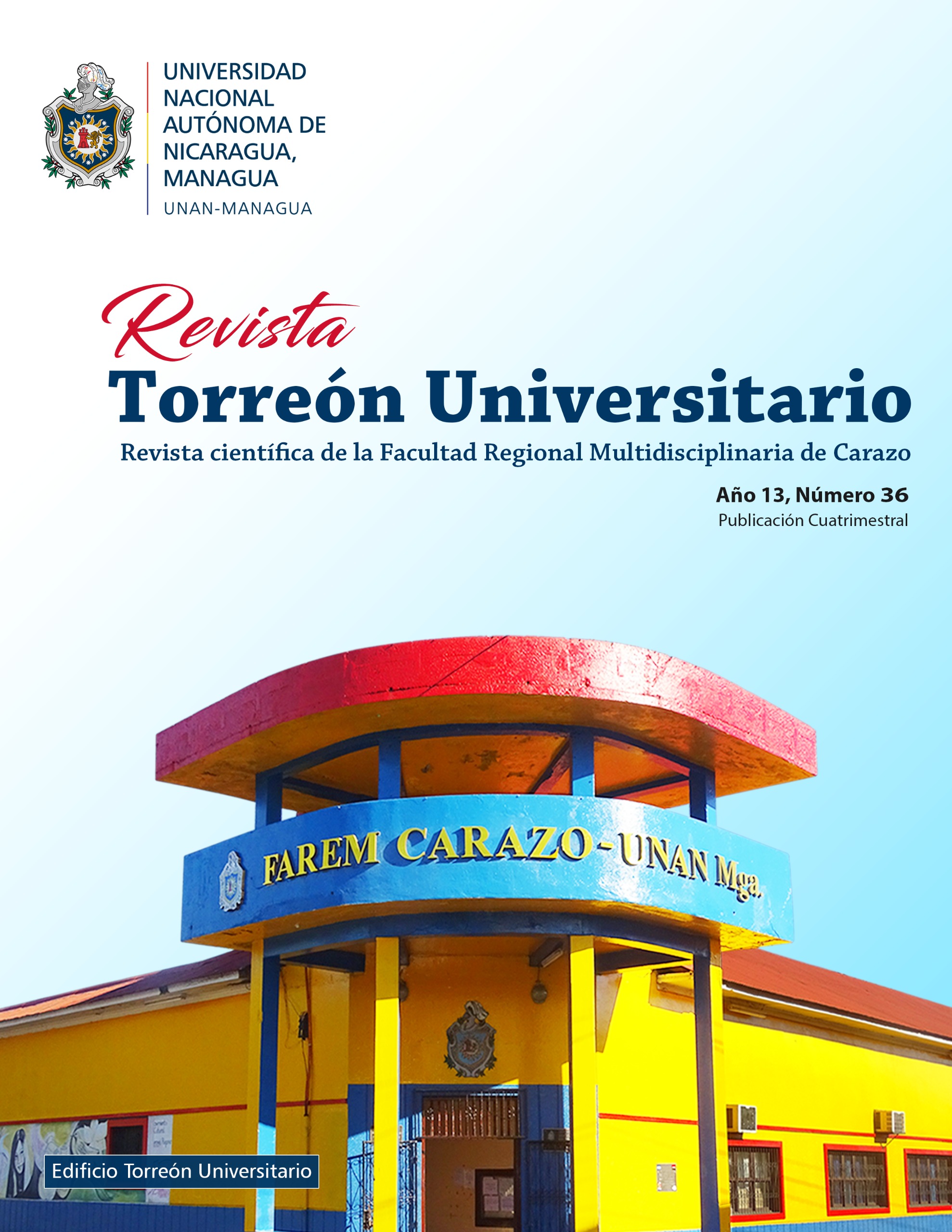Assessment of compliance with regulation 100 on integrated epidemiological surveillance of IRAS by health professionals from the Dr. Alejandro Dávila Bolaños Masaya-Nicaragua health center, april to september 2022
DOI:
https://doi.org/10.5377/rtu.v13i36.17635Keywords:
Compliance, IRAS, Regulations 100Abstract
Objective: To analyze compliance with regulation 100 on the integrated epidemiological surveillance of IRAS, establishing the internal and external characteristics of the institution by health professionals from the Dr. Alejandro Davila Bolaños Health Center in the city of Masaya Nicaragua, April to September 2022. Methodological design: It is a study with a qualitative research-action-participation approach, in the integrated epidemiological surveillance of acute respiratory infections. Universe and sample: 66 health unit workers in charge of providing care to people with acute respiratory infections. Results: Strengths were determined in the health unit, such as a broad portfolio of services and solid inter-institutional coordination, managing to maintain the focus on promotion and prevention. Optimizing the monthly scheduling of medical supplies; identifying weaknesses on the part of health personnel in the use of personal protective equipment and the safe transport of infectious substances, objectively visualizing and addressing the monitoring actions of the health unit's management team, allowing the creation of continuing education strategies and administration of medical supplies. Conclusions: The visualization of the findings found in the evaluation of regulation 100 in the integrated surveillance of HAIs allowed the personnel under study and the institution to establish the daily report of respiratory symptoms, the training of the regulations was developed; emphasizing the flow of care, protective equipment, transportation of infectious substances and waste segregation.
Downloads
References
Agencia de cooperación internacional del Japón JICA. (2022). Guía Básica Para Fortalecer el Trabajo del ESAFC/GISI. Managua, Nicaragua: MINSA.
Carmona, E. A. (2022). Relación entre las practicas organizacionales saludables y la satisfacción laboral. Andalucía, España.
Centros para el Control y la Prevención de Enfermedades, C. N. (31 de AGOSTO de 2021). CDC. Obtenido de CDC: https://espanol.cdc.gov/flu/treatment/whatyoushould.htm
Centros para el Control y la Prevención de Enfermedades, C. N. (26 de agosto de 2021). CDC. Obtenido de https://espanol.cdc.gov/flu/about/keyfacts.htm
Centros para el Control y la Prevención de Enfermedades, C. N. (14 de SEPTIEMBRE de 2021). CDC. Obtenido de https://espanol.cdc.gov/flu/symptoms/testing.htm
Dr. Guillermo González, D. A. (2008). Modelo de Salud Familiar y comunitario: Manual y Funcionamiento del Sector. MINSA. Managua, Nicaragua.
García Galindo, A. M. (2018). “Nivel de conocimiento de pacientes sobre el h1n1 y su relación con el nivel de información que brindan los proveedores del puesto de salud Micaela Bastidas distrito de villa maría de triunfo”2018. (U. N. Villareal, Ed., & V. d. investigación., Trad.) Lima, Perú: Tesis de Maestría en Salud Publica. Obtenido de http://repositorio.unfv.edu.pe/bitstream/handle/UNFV/2742/GARCIA%20GALINDO%20ANGEL%20MAURO%20-%20MAESTRIA.pdf?sequence=1&isAllowed=y
Gobierno de Reconciliación y Unidad Nacional. (2021). Normativa-195 Sistema de Vigilancia para la Salud Publica. Obtenido de https://www.minsa.gob.ni/index.php/repository/Descargas-MINSA/Direcci%C3%B3n-General-de-Regulaci%C3%B3n-Sanitaria/Normas-Protocolos-y-Manuales/
Maristela Izcak Baldissera, C. V. (29 de agosto de 2022). Características del trabajo en atención primaria identificadas en el ejercicio colectivo de aplicación de la matriz FODA. Revista Brasileira de Enfermagem, 8. doi:https://doi.org/10.1590/0034-7167-2022-0443
MINSA. (2008). Marco Conceptual Modelo de Salud Familiar y comunitario. Managua, Nicaragua. Obtenido de https://www.minsa.gob.ni/
Mora Amador, G. A. (2020). Comportamiento clínico de los pacientes con influenza confirmado, en el servicio de pediatría del Hospital Fernando Vélez Páiz período 2018-2020. Managua, Tesis: Repositorio Institucional UNAN - Managua. Obtenido de https://repositorio.unan.edu.ni/16147/1/16147.pdf
OPS. (Periodo 2009 – 2013, Consultoría Privada 2009). Plan estratégico del ministerio de salud pública,
Palma, L. P. (2009). Aplicación de los procedimientos operativos estandarizados en la determinación del virus influenza, centro de salud Sócrates Flores. Managua. Periodo Octubre a diciembre. Managua, Nicaragua. Obtenido de https://repositorio.unan.edu.ni/cgi/search/simple
publica, s. d. (2009). guía para el diagnóstico y tratamiento de la influenza A h1n1.
Salud, M. d. (2018). Normativa 100 "GUIA PARA LA VIGILANCIA EPIDEMIOLOGICA DE LAS INFECCIONES RESPIRATORIAS AGUDAS. MANAGUA.
SALUD, M. D. (2020). Norma del sistema de vigilancia para la salud pública. Managua.
SALUD, O. P. (agosto 2002). Protección de la salud mental en situaciones de desastres y emergencias, Manuales y Guías sobre desastres.
Social, M. d. (2008). Guía de atención clínica para la influenza pandémica. el salvador.
Suarez, L. G. (diciembre 2018). Estrategias para mejorar el desempeño en unidades centinelas de influenza en la jurisdicción sanitaria I, Cuernavaca. Cuernavaca, Morelos, México: Universidad autónoma del estado de Morelos. Obtenido de http://riaa.uaem.mx/xmlui/bitstream/handle/20.500.12055/1764/ROSGLR08T.pdf?sequence=1&isAllowed=y
Teresa García López, M. C. (2013). EL FODA: Una técnica para el análisis de problemas en el contexto de la planeación en las organizaciones. Universidad Veracruzana. Obtenido de TG López, MC Flores - Recuperado de https://www. uv. mx/iiesca …, 2013 - gc.scalahed.com
Vilca Flores, E. M. (2018). Factores que determinan el uso correcto de los respiradores N95 en el personal de salud del Servicio de Emergencia del hospital san Juan de Lurigancho. Lima, Perú: Universidad María Auxiliadora. Obtenido de https://repositorio.uma.edu.pe/
Published
How to Cite
Issue
Section
License
Copyright (c) 2024 National Autonomous University of Nicaragua, Managua

This work is licensed under a Creative Commons Attribution-NonCommercial-NoDerivatives 4.0 International License.
The authors who publish in this journal agree to the following terms.
- The author or authors of the articles, essays or research grant the National Autonomous University of Nicaragua, Managua (UNAN-Managua) the editing rights (copyright) of the submitted work, therefore the University has the exclusive right to publish the article for the entire copyright period.
- These copyrights/authors authorize Torreón Universitario Magazine and the University to edit and disseminate/publish the article in said Magazine, including printed and electronic reproduction, storage, retrieval and any other type of publication, and sources of secondary information as services. of summaries and databases, they also empower it to protect the article against unauthorized use for dissemination by printed or electronic media (PDF, HTML, EPUB, XML or others).
License for use of content
The magazine uses the Creative Commons Attribution-NonCommercial-NoDerivs 4.0 International License.
Under this statement:

This journal is licensed under a Creative Commons Attribution-NonCommercial-NoDerivatives 4.0 International License. It can be copied, distributed and transmitted publicly as long as the author and source are cited (Revista Torreón Universitario), it should not be modified or used for any commercial purpose. The full license can be found at http://creativecommons.org/licenses/by-nc-nd/4.0/.



